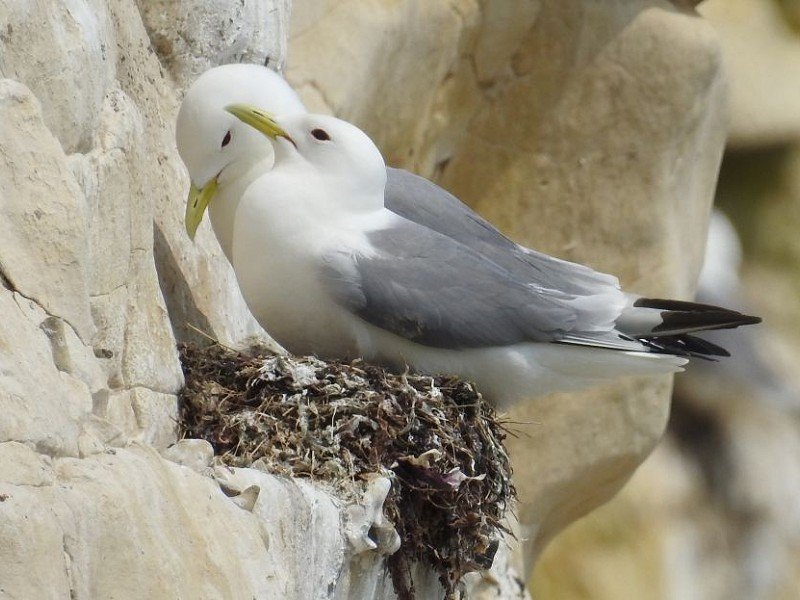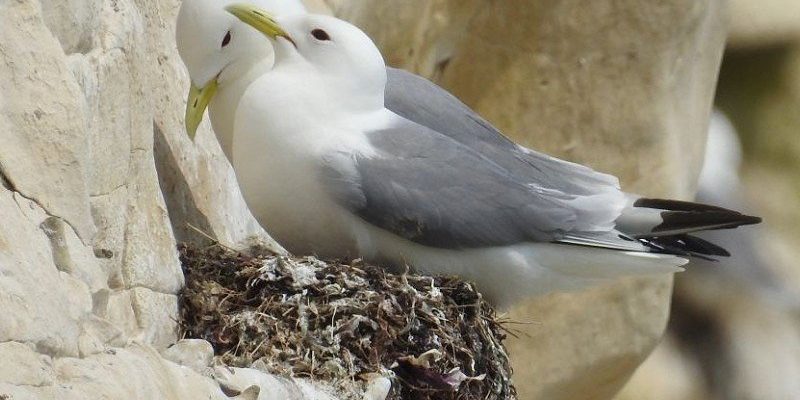
The world of seabirds is filled with fascinating creatures, but few are as charming as the Kittiwake. With their distinctive calls and striking appearance, these birds have captivated the hearts of birdwatchers and nature enthusiasts alike. Imagine a small, agile bird, gliding effortlessly over the ocean waves, its white body contrasting against the blue sky. That’s a Kittiwake for you!
You might be wondering what makes these birds so special. Well, Kittiwakes are not just pretty faces; they play an essential role in marine ecosystems. They are known for their unique nesting habits and social behavior, often forming large colonies that create quite the spectacle! In this article, we’ll dive into all the interesting details about Kittiwakes, from their habitats and diets to their behaviors and conservation status.
Physical Characteristics of Kittiwakes
Kittiwakes are medium-sized gulls, typically measuring about 14 to 16 inches in length. They have a wingspan that can stretch up to 38 inches, allowing them to soar gracefully over the ocean. One of the most striking features of Kittiwakes is their plumage. Adults usually have a bright white body with a soft gray back and wings. Their head shows a beautiful black cap during the breeding season, which adds to their aesthetic charm.
Another interesting characteristic is their yellow bill, which is relatively short compared to other gull species. This adaptation helps them catch small fish and marine invertebrates, which make up the bulk of their diet. Young Kittiwakes, on the other hand, have mottled brown feathers that gradually turn white as they mature. This variation helps them blend into their nesting environment, providing a layer of protection against predators.
Habitat and Distribution
Kittiwakes are primarily found in *cold coastal waters*, ranging from the icy shores of Alaska to the temperate regions of Europe. They prefer cliffs and steep rocky coastlines for nesting, using the vertical surfaces to keep their eggs safe from ground predators. You might spot Kittiwakes in places like the North Atlantic and the Arctic regions, where they are often seen soaring over the waves or gathered in large groups along the shore.
During the breeding season, Kittiwakes return to their colonies, which can number in the thousands. These colonies are often located on sea cliffs, where the birds nest on ledges or in crevices. Outside of the breeding season, Kittiwakes can be seen foraging in open waters, where they search for food. They are migratory birds, so they typically travel south to find warmer waters during the winter months.
Diet and Feeding Habits
The diet of a Kittiwake mainly consists of small fish, such as herring and sprats, as well as various types of *zooplankton*. They have an interesting feeding technique; they often dive into the water to catch fish or snatch small prey from the surface while flying. Kittiwakes can be quite agile, demonstrating impressive acrobatics when chasing after their meals.
Here’s the thing about their feeding habits: Kittiwakes are also known to scavenge from fishing boats, taking advantage of the easy pickings. This behavior can sometimes lead them to congregate in large numbers near fishing vessels, creating a lively scene as they squawk and dive for scraps. Their ability to adapt to different feeding strategies has helped them thrive in various environments.
| Species | Kittiwake |
| Length | 14-16 inches |
| Wingspan | 38 inches |
| Habitat | Coastal cliffs and open ocean |
| Diet | Fish and zooplankton |
| Lifespan | 10-15 years |
Breeding and Nesting Behavior
When it comes to breeding, Kittiwakes are quite social. They often return to the same colony year after year, forming strong pair bonds. The breeding season typically begins in late spring, when both male and female Kittiwakes participate in building their nests. Using grass, seaweed, and feathers, they create a sturdy platform on cliff ledges, which provides a safe haven for their chicks.
Once the nest is complete, the female lays usually one to three eggs, which she incubates for about 28 days. During this time, the male will take turns watching for predators and bringing food back to the nest. After hatching, the chicks are covered in soft down and are relatively helpless. However, they grow quickly, and within a few weeks, they begin to fledge and learn to fly. This process is nothing short of remarkable!
Social Behavior and Communication
Kittiwakes are very social birds, often seen in large flocks both on land and at sea. They communicate with a range of vocalizations that sound like their name—hence the charming title “Kittiwake.” Their calls can be described as a series of high-pitched, repetitive sounds that create a lively atmosphere in their colonies. It’s almost as if they’re having constant conversations with each other!
This social nature not only makes them fun to watch but serves a purpose too. By staying in groups, Kittiwakes can keep an eye out for potential threats, such as predators. They also engage in social behaviors like preening and mutual grooming, which help strengthen bonds among individuals in the colony. It’s a community affair that showcases their interconnectedness as a species.
Conservation Status
Like many wildlife species, Kittiwakes face challenges that threaten their populations. Although they are currently classified as Least Concern, their numbers have seen a significant decline in some regions due to habitat loss, climate change, and overfishing. As the ocean warms and fish populations shift, Kittiwakes may struggle to find enough food, which directly impacts their ability to breed and raise their young.
Conservation efforts are essential to ensure the survival of Kittiwakes in the wild. Organizations and researchers are working to monitor their populations and promote practices that protect their habitats. By raising awareness about Kittiwakes and their ecological importance, we can contribute to their preservation and support these beautiful birds for generations to come.
FAQ
Where can I see Kittiwakes in the wild?
If you’re keen on spotting Kittiwakes, coastal areas with rocky cliffs are great places to start. They are commonly found along the coasts of North America, Europe, and parts of Asia. Visiting during the breeding season (late spring to early summer) increases your chances of seeing them nesting and interacting in colonies.
What do Kittiwakes sound like?
Kittiwakes make a variety of sounds that can be quite delightful to hear. Their calls are often described as high-pitched “kittiwake” noises, which are both repetitive and melodic. You may hear these calls echoing in the air when you’re close to their nesting sites, adding a lively ambiance to their coastal habitats.
Are Kittiwakes migratory birds?
Yes, Kittiwakes are migratory birds. They typically spend their breeding season in the cooler northern regions but migrate south to warmer waters during the winter months. This seasonal movement helps them find food more easily when conditions change.
How long do Kittiwakes live?
Kittiwakes generally have a lifespan of about 10 to 15 years in the wild. However, some individuals may live longer if they can avoid predators and environmental dangers. Their longevity can vary based on habitat quality and food availability.
What do Kittiwakes eat?
Kittiwakes primarily feed on small fish and marine invertebrates like *zooplankton*. They are skilled hunters, often diving into the water to catch their prey or snatching it from the surface while flying. Their diet can greatly influence their overall health and breeding success.
How can I help Kittiwakes?
You can help Kittiwakes by supporting conservation efforts aimed at protecting their habitats and food sources. Educating yourself and others about the importance of these birds can also make a difference. Additionally, consider participating in local clean-up events at beaches and coastal areas to help preserve their environment.
Do Kittiwakes have any natural predators?
Yes, Kittiwakes face a few natural predators, particularly during the nesting season. Birds of prey, such as gulls and eagles, often target Kittiwake eggs and chicks. Additionally, terrestrial predators like foxes may pose a threat to nests located on the ground, emphasizing the need for secure nesting sites on cliffs.
Can Kittiwakes swim?
While Kittiwakes are primarily aerial and coastal birds, they can swim to some extent. They often take to the water when foraging for food or escaping from predators. However, their preferred method of movement is flying, which allows them to cover larger distances more efficiently.
Where do Kittiwakes nest?
Kittiwakes typically nest on steep, rocky cliffs along coastal areas. They prefer ledges or crevices that offer protection from predators. These nesting sites are crucial for the safety of their chicks, allowing them to thrive in a relatively safe environment.
What is the difference between Kittiwakes and other gull species?
Kittiwakes differ from other gull species primarily in their breeding behavior, nesting preferences, and calls. Unlike many gulls that nest on the ground, Kittiwakes prefer cliffside nesting. They also have distinct vocalizations that set them apart, characterized by their charming “kittiwake” calls.
Are Kittiwakes social birds?
Absolutely! Kittiwakes are very social creatures. They often gather in large colonies, especially during the breeding season. Their social behavior includes vocalizations, mutual grooming, and flocking, which helps them stay safe and connected within their communities.
What threats do Kittiwakes face today?
Today, Kittiwakes face several threats, including habitat loss due to coastal development, climate change, and overfishing of their food sources. These factors can lead to declining populations and pose significant challenges for their long-term survival. Conservation efforts are critical to mitigate these threats and protect Kittiwakes.

